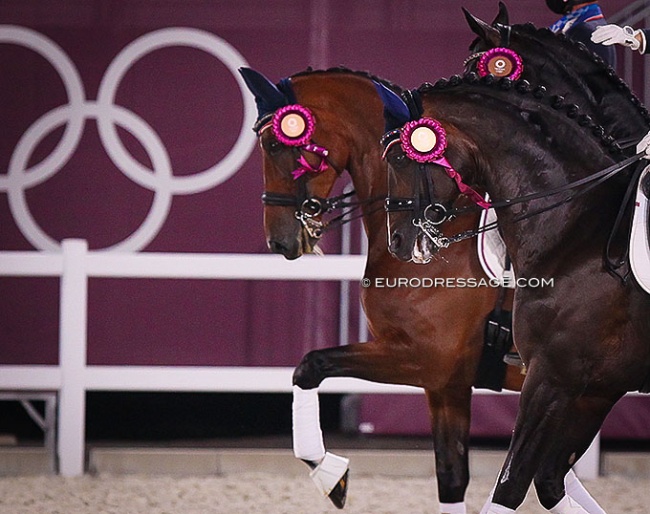
- by David Stickland of Global Dressage Analytics
In just a few hours the Tokyo 2020 Individual Dressage Championship will take place. Eighteen riders, who have fought through the Grand Prix and the Special for their Teams, will now be in competition with each other for that magical Olympic Gold medal.
Each Combination at Their Best
This competition up to now has been exhilarating, and this Freestyle promises to be just as exciting. It is the first “serious” Freestyle competition with a world class field probably since the Rotterdam EU-CH back in August 2019. Something came up between then and now and we lost most of the truly international competitions. But finally, it is here.
I do a lot of predicting, but I am not going to even try this time. Many of the combinations tomorrow have not performed a Freestyle recently and some of them have, I believe, created completely new freestyles for this Olympic competition; there just isn’t enough useable information out there to make a safe prediction from, and anyway, I am as excited as the next person to see how it will develop. The Individual freestyle is not about tactics or strategies, it is about each combination achieving their best.
Separate the Winners from the Runners Up
So, if we can’t predict, we can look back and see what are the factors that separate the winners from the runners up? And why not use that EU-CH in Rotterdam as the place to start. Actually, seven of the horses and nine of the riders from Rotterdam will be competing today in Tokyo.
The top three from Rotterdam could even end up, in some combination, as the top three in Tokyo, but there are at least four other combinations who have a realistic chance of a medal also.
Piaffe Passage and Pirouette in Your Kur
The makeup of the Freestyle is that 50% of the points are Technical, 50% are Artistic. Within the Technical marks whereas 42% of the Special marks are related to Passage, Piaffe and Transitions and 9% are related to the Pirouettes, in the Freestyle it is 25% Passage-Piaffe-Transitions and 20% Pirouettes! The mix is very different.
However, just because 20% of the marks are Pirouettes that doesn’t mean that 20% of the ranking is made up of Pirouette scores – if everyone were to score the same for some movement, then it wouldn’t affect the ranking at all. What is important is the spread in scores for a particular movement, that is what decides the ranking.
Artistic Marks Decide the Medallists
So, the big picture first, it is 50% Technical and 50% Artistic, but which affects the Ranking the most? To answer that I show the spread in total Technical and Artistic scores for the 15 riders in Rotterdam, but I divide them into three groups; those finally ranked 1-5, those 6-10 and those 11-15. This in itself is remarkable! For the riders ranked 11-15 the spread in scores is 50:50, Technical and Artistic marks are equally important in the ranking, for the middle group it is 39:61 and for the top group 36:64! 64% of the final ranking between the top 5 riders comes from the Artistic marks.

Another way of looking at it that they all score about the same Technical (perhaps with a different mix of best and worst movements) and it comes down to the Artistic marks to separate them. In fact, those top 5 riders have Technical scores that span the narrow range from 80.3% to 84.3%, whereas the third group range from 64% to 74%.
Moral of that story: If you have the technical skills to score up there, you had better invest a lot of effort in the Freestyle design and Music!
Killer Skill
We can also look in more detail, what are the marks that actually generate the ranking, we could do that for each group, and indeed it is quite different for each group, but to keep the article short and not lose your attention we first look at the Top-5.
Those Pirouettes, that were 20% of the Technical score, actually contribute 15% to the ranking, while the Passage-Piaffe-Transitions (PPT) that were 25% of the marks, contribute 42% of the ranking. That doesn’t mean you can forget about your Pirouettes; it means if you are in that top 5 then your Pirouettes are not so different from the others; but the PPT is still the killer skill in the ranking.
On the Artistic side it is that Harmony that will buy you the best final rank; again it doesn’t mean the others are not important, using that same old music is not your solution, it means that your competitors have also got great music, that’s how you are all in that club, but the Harmony is what will have the biggest say in your final Ranking – which sounds to me just right!

In the Middle Field
Which is brings us to the end of this story, except for one last exercise, below we have the same plots for the second group of 5 riders (ranked 6-10). The ranking depends on a very different mix! The PPT is now counting for just 13% instead of 42%.
Also, in the middle of the field, maybe you’d better spend a bit more on that Choreography and Music and probably everyone has a similar degree of difficulty, so it doesn’t affect the ranking so much! (Sorry, Gareth – that wasn’t your best Halt ☺, but even if I remove it, the PPT still only counts for 15% of the Technical ranking)
by David Stickland
Related Link
Eurodressage Coverage of the 2021 Olympic Games
